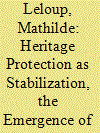|
|
|
Sort Order |
|
|
|
Items / Page
|
|
|
|
|
|
|
| Srl | Item |
| 1 |
ID:
166782


|
|
|
|
|
| Summary/Abstract |
The integration of new tasks like those of cultural and natural heritage management into the mandates of UN peace operations is usually presented as a burden, ‘a star on the top of the Christmas tree’ at a time of scarce human and budgetary resources for contemporary UN peace operations. Through a comparison of MINUSMA in Mali and MONUSCO in DRC, this article aims to demonstrate how, on the contrary, heritage management can bring consistency to the broader ‘stabilization’ mandate mainstreamed in UN peace operations. By creating new links between the seemingly dichotomous activities it encompasses, namely ‘support’ and ‘securization’ activities, this new type of mandated task can increase complementarity between civilian and military components of UN peace operations with regard to local population. As part of their stabilization mandates, both MINUSMA and MONUSCO were charged to protect heritage. Ultimately, the most decisive factor as to why heritage management created a virtuous circle in Mali and a vicious circle in DRC, seems to be the failure or the success on the part of peace operations to include local communities in the heritage management process, a task which is so far better performed by the civilian than by the military component.
|
|
|
|
|
|
|
|
|
|
|
|
|
|
|
|
| 2 |
ID:
103852


|
|
|
|
|
| Publication |
2011.
|
| Summary/Abstract |
This article critically appraises and evaluates tourism strategies and heritage management in Luang Prabang, Lao People's Democratic Republic, a Unescodesignated "world heritage" city. Luang Prabang is widely regarded as one of the most significant heritage cities in Southeast Asia. The city is renowned for its Buddhist and royal culture and also its historic vernacular Lao, French, and Lao-French architecture. The city earned world heritage status in 1995, but since that time the boom in in-bound Asian tourism has put pressures on Luang Prabang's authenticity and, for some, called into question the validity of its world heritage status. This article examines these substantial and wide-ranging pressures and argues that the growth in tourism and the treatment of Luang Prabang's heritage are symptoms of broader regional processes of political and economic change, including the expansion of Chinese and Korean investment and the growth of intra-regional tourism. The authors argue that it is unreasonable to expect traditional heritage management mechanisms, including the world heritage listing, to be able to cope with the pressures on sites like Luang Prabang. The very least that is required, the authors contend, is an expanded understanding of the context in which heritage places sit, and the authors make a case that the cultural landscapes approach, combined with explicit concern for intangible heritage and poverty alleviation, must be at the core of any strategy for long-term protection of the city's cultural heritage values.
|
|
|
|
|
|
|
|
|
|
|
|
|
|
|
|
|
|
|
|
|